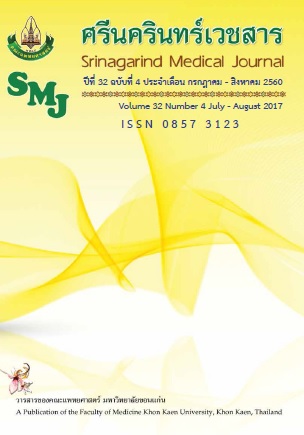A Comparative Study of Thai Herbal Hot Pack and Hot Pack in Pain Treatment of Low Back Pain: A Randomized Controlled Trial
คำสำคัญ:
Thai herbal hot pack, visual analog scale, sit and reach test, non-specific low back pain, แผ่นประคบร้อนสมุนไพรไทย, มาตรวัดความเจ็บปวดด้วยสายตา, การทดสอบนั่งงอตัวไปด้านหน้า, การปวดหลังแบบไม่ทราบสาเหตุบทคัดย่อ
Background and Objective: Thai herbal compress is the Thai traditional superficial heat treatment that is popular in public health services facilities. Nowadays, there was the development of Thai herbal hot pack by microwave to be the alternative way for the treatment of painful syndromes but no randomized control study have determined the effect of Thai herbal hot pack. The purpose of this study was to evaluate the effect of Thai herbal hot pack treatment on pain and flexibility in low back pain.
Methods: This study was a randomized control trial (single-blind tester). Forty subjects with non-specific low back pain were randomly assigned to an experimental group (n=20) and a control group (n=20). The experimental group received the 30-minutes session of Thai herbal hot pack (three times for a week) while the control group received the hot pack treatment. All subjects were measured pain and flexibility by visual analog scale and sit and reach test, respectively.
Results: Both groups showed the statistically significant difference of pain between before and after treatment (p = 0.000) but no difference was found between treatments. However, the mean difference of flexibility significantly increased more in experimental group (p = 0.014).
Conclusions: Both treatment showed the same effect on pain reduction in non-specific low back pain subjects. However, the Thai herbal hot pack treatment had increased flexibility of lower back muscle than hot pack. Thus, Thai herbal hot pack may be an alternative way to pain reduction and flexibility increment.
การเปรียบเทียบผลของแผ่นประคบร้อนสมุนไพรไทยและแผ่นประคบร้อนในการรักษาผู้ที่มีอาการปวดหลังส่วนล่าง: การทดลองแบบสุ่มและมีกลุ่มควบคุม
ณิชาภา พาราศิลป์1*, ศิรินทิพย์ คำฟู1, อรรจน์มน ธรรมไชย1
1สาขาวิชากายภาพบำบัด คณะสหเวชศาสตร์ มหาวิทยาลัยพะเยา
* ผู้รับผิดชอบบทความ (สาขาวิชากายภาพบำบัด คณะสหเวชศาสตร์ มหาวิทยาลัยพะเยา 19 หมู่ 2 ตำบลแม่กา อำเภอเมือง จังหวัดพะเยา 56000
หลักการและวัตถุประสงค์: ลูกประคบสมุนไพรไทยเป็นการรักษาด้วยความร้อนตื้นแบบดั้งเดิมของไทยซึ่งเป็นที่นิยมในการบริการด้านสาธารณสุข ปัจจุบันนี้มีการพัฒนาแผ่นประคบร้อนสมุนไพรไทยด้วยเตาไมโครเวฟขึ้นเพื่อเป็นทางเลือกการรักษาสำหรับผู้ป่วยกลุ่มอาการปวด แต่ยังไม่มีการศึกษาแบบสุ่มและมีกลุ่มควบคุมเกี่ยวกับการศึกษาผลของการรักษาด้วยแผ่นประคบร้อนสมุนไพรไทย วัตถุประสงค์ของการศึกษานี้คือศึกษาผลของการรักษาด้วยแผ่นประคบร้อนสมุนไพรไทยต่ออาการปวดและความยืดหยุ่นในผู้ที่มีอาการปวดหลังส่วนล่าง
วิธีการศึกษา: การศึกษานี้เป็นการศึกษาเชิงทดลองแบบสุ่มและมีกลุ่มควบคุม (single-blind tester) อาสาสมัครที่มีอาการปวดหลังส่วนล่างแบบไม่ทราบสาเหตุ 40 ราย ได้รับการสุ่มเข้ากลุ่มทดลอง 20 ราย หรือกลุ่มควบคุม 20 ราย กลุ่มทดลองจะได้รับการรักษาด้วยแผ่นประคบร้อนสมุนไพรไทยนาน 30 นาทีต่อครั้ง (3 ครั้ง เป็นเวลา 1 สัปดาห์) ในขณะที่กลุ่มควบคุมได้รับการรักษาด้วยแผ่นประคบร้อน อาสาสมัครทุกท่านถูกประเมินความเจ็บปวดและความยืดหยุ่นด้วยมาตรวัดความเจ็บปวดด้วยสายตาและการทดสอบนั่งงอตัวไปด้านหน้าตามลำดับ
ผลการศึกษา: ทั้งสองกลุ่มมีความแตกต่างอย่างมีนัยสำคัญทางสถิติของความเจ็บปวดระหว่างก่อนและหลังการรักษา(p = 0.000) แต่ไม่พบความแตกต่างระหว่างกลุ่ม อย่างไรก็ตาม พบว่าค่าเฉลี่ยความแตกต่างของความยืดหยุ่นเพิ่มขึ้นมากกว่าอย่างมีนัยสำคัญทางสถิติในกลุ่มทดลอง(p = 0.014)
สรุป: ทั้งสองการรักษาสามารถลดอาการปวดในผู้ที่มีอาการปวดหลังส่วนล่างได้เช่นเดียวกัน อย่างไรก็ตาม การรักษาด้วยแผ่นประคบร้อนสมุนไพรสามารถเพิ่มความยืดหยุ่นของกล้ามเนื้อหลังได้ดีกว่าการรักษาด้วยแผ่นประคบร้อน ดังนั้นแผ่นประคบร้อนสมุนไพรไทยอาจจะเป็นทางเลือกสำหรับการลดความเจ็บปวดและเพิ่มความยืดหยุ่นได้




